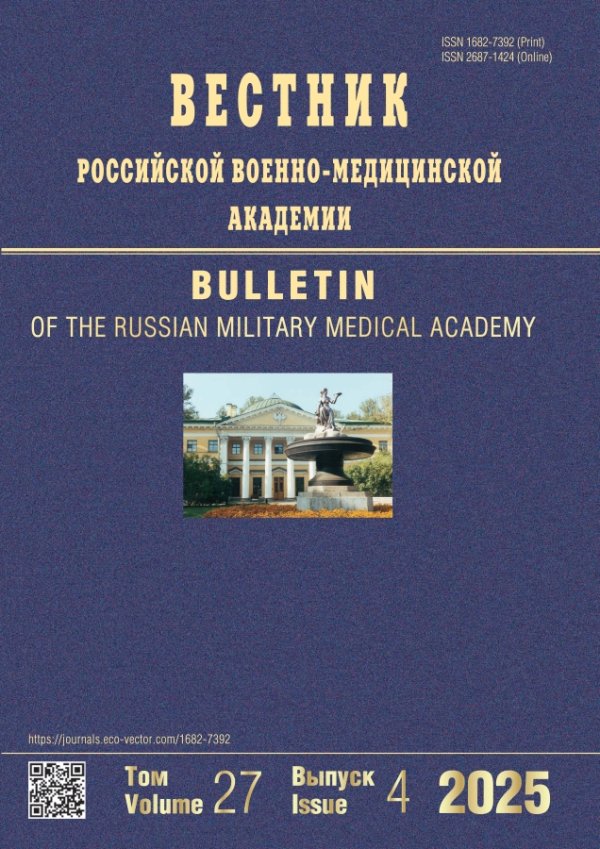Очаги хронической инфекции и сосудистая ригидность у лиц призывного возраста
- Авторы: Евсевьева МЕ1, Ерёмин МВ1, Итальянцева ЕВ1, Ростовцева МВ1, Сергеева ОВ1
-
Учреждения:
- Ставропольский государственный медицинский университет
- Выпуск: Том 20, № 1 (2018)
- Страницы: 149-153
- Раздел: Статьи
- URL: https://journals.rcsi.science/1682-7392/article/view/12280
- DOI: https://doi.org/10.17816/brmma12280
- ID: 12280
Цитировать
Полный текст
Аннотация
Полный текст
Открыть статью на сайте журналаОб авторах
М Е Евсевьева
Ставропольский государственный медицинский университет
Email: evsevieva@mail.ru
Ставрополь
М В Ерёмин
Ставропольский государственный медицинский университетСтаврополь
Е В Итальянцева
Ставропольский государственный медицинский университетСтаврополь
М В Ростовцева
Ставропольский государственный медицинский университетСтаврополь
О В Сергеева
Ставропольский государственный медицинский университетСтаврополь
Список литературы
- Евсевьева, М.Е. Студенческая диспансеризация в аспекте развития диагностических технологий / М.Е. Евсевьева [и др.] // Рос. кард. жур. - 2016. - № 4s - 1 (132). - С. 28.
- Калинина, А.М. Эпидемиологические методы выявления ос- новных хронических неинфекционных заболеваний и факто- ров риска при массовых обследованиях населения: учебное пособие / А.М. Калинина [и др.]. - М.: ГНИЦ, 2015. - 96 с.
- Оганов, Р.Г. Индивидуальная профилактика сердечно-сосуди- стых заболеваний. Позиция европейских кардиологических обществ / Р.Г. Оганов [и др.] // Кардиоваскулярная терапия и профилактика. - 2017. - № 1. - С. 4-7.
- Васюк, Ю.А. Согласованное мнение российских экспертов по оценке артериальной жесткости в клинической практике / Ю.А. Васюк [и др.] // Кардиоваскулярная терапия и про- филактика. - 2016. - № 2. - С. 4-19.
- Титов, В.Н. Общность атеросклероза и воспаления: специфич- ность атеросклероза как воспалительного процесса / В.Н. Титов / Рос. кард. жур. - 2000. - № 5. - С. 48-56.
- Burgner, D.P. Early childhood hospitalisation with infection and subclinical atherosclerosis in adulthood: the Cardiovascular Risk in Young Finns Study / D.P. Burgner [et al.] // Atherosclerosis. - 2015. - № 239. - Р. 496-502.
- Burgner D.P. Infection-related hospitalisation in childhood and adult metabolic outcomes / D.P. Burgner [et al.] // Pediatrics. - 2015. - № 136. - Р. 554-562.
- Dratva, J. Infectious diseases are associated with carotid intima media thickness in adolescence / J. Dratva [et al.] // Atherosclerosis. - 2015. - № 243. - Р. 609-615.
- Massimo, F. 2016 ESC Guidelines on cardiovascular disease prevention in clinical practice: The Sixth Joint Task Force of the European Society of Cardiology and Other Societies on Cardiovascular Disease Prevention in Clinical Practice / F. Massimo // Eur. Heart J. - 2016. - № 37. - Р. 2315-2381.
- Evsevyeva, M.E. Angiologic screening of young population in South Region of Russia: experience with cardio-ankle index / M.E. Evsevyeva [et al.] // J. Hypertens. - 2017. - № 35 (S2). - Р. 245.
- McGill, H. Pathology of Atherosclerosis in Youth and the Cardiovascular Risk Factors / H. McGill, C. [et al.] // In: Pediatric Prevention of Atherosclerotic Cardiovascular Disease. - Oxford, 2006. - Vol. 3. - 26 р.
- Ott, S.J. Detection of diverse bacterial signatures in atherosclerotic lesions of patients with coronary heart disease / S.J. Ott [et al.] // Circulation. - 2006. - № 113. - Р. 929-937.
- Pessi, T. Bacterial signatures in thrombus aspirates of patients with myocardial infarction / Т. Pessi [et al.] // Circulation. - 2013. - № 127. - Р. 1219-1228.
- Qanitha, А. Infections in early life and premature acute coronary syndrome: A case-control study / А. Qanitha [et al.] // European Journal of Preventive Cardiology. - 2016. - № 23 (15). - Р. 1640-1648.
- Sun, C. Effects of earlylife environment and epigenetics on cardiovascular disease risk in children: highlighting the role of twin studies / C.Sun [et al.] // Pediatr Res. - 2013. - № 73. - Р. 523-530.
Дополнительные файлы







